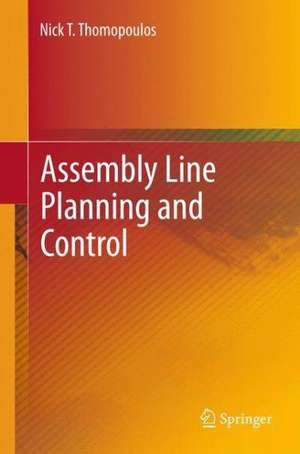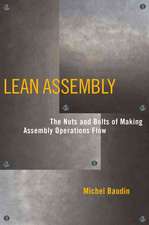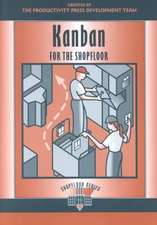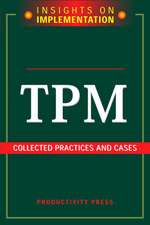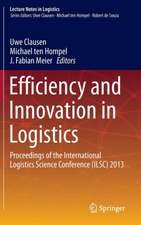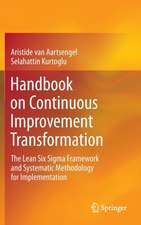Assembly Line Planning and Control
Autor Nick T. Thomopoulosen Limba Engleză Hardback – 24 sep 2013
| Toate formatele și edițiile | Preț | Express |
|---|---|---|
| Paperback (1) | 684.85 lei 6-8 săpt. | |
| Springer International Publishing – 23 aug 2016 | 684.85 lei 6-8 săpt. | |
| Hardback (1) | 694.87 lei 6-8 săpt. | |
| Springer International Publishing – 24 sep 2013 | 694.87 lei 6-8 săpt. |
Preț: 694.87 lei
Preț vechi: 817.50 lei
-15% Nou
Puncte Express: 1042
Preț estimativ în valută:
132.97€ • 137.38$ • 110.61£
132.97€ • 137.38$ • 110.61£
Carte tipărită la comandă
Livrare economică 19 martie-02 aprilie
Preluare comenzi: 021 569.72.76
Specificații
ISBN-13: 9783319013985
ISBN-10: 331901398X
Pagini: 164
Ilustrații: XVI, 145 p. 10 illus. in color.
Dimensiuni: 155 x 235 x 13 mm
Greutate: 0.36 kg
Ediția:2014
Editura: Springer International Publishing
Colecția Springer
Locul publicării:Cham, Switzerland
ISBN-10: 331901398X
Pagini: 164
Ilustrații: XVI, 145 p. 10 illus. in color.
Dimensiuni: 155 x 235 x 13 mm
Greutate: 0.36 kg
Ediția:2014
Editura: Springer International Publishing
Colecția Springer
Locul publicării:Cham, Switzerland
Public țintă
ResearchCuprins
Introduction.- Assembly Systems.- Some Fundamentals.- Preliminary Planning.- Inventory Replenishments.- Single Model Assembly.- Mixed Model Make-to-Stock Assembly.- Mixed Model Make-to-Order Assembly.- Postponement Assembly.- One Station Assembly.- Similarity Index.- Learning Curves.
Notă biografică
Nick T. Thomopoulos has degrees in business (B.S.) and in mathematics (M.A.) from the University of Illinois, and in industrial engineering (Ph.D.) from Illinois Institute of Technology. He was supervisor of operations research at International Harvester; senior scientist at IIT Research Institute; and is a professor emeritus at Illinois Institute of Technology. He is the co-author of Humanism and Technology in Assembly Line Systems, Hayden Books; author of Applied Forecasting Methods, Prentice Hall; Inventory Management and Planning, Hitchcock Publishing Company; Fundamentals of Queuing Systems, Springer; Fundamentals of Production, Inventory and the Supply Chain, Atlantic; and Essentials of Monte Carlo Simulation, Springer. He has published numerous papers, and for many years he has consulted in a wide variety of industries in the United States, Europe and Asia. Nick has received honors over the years, such as the Rist Prize from the Military Operations Research Society for new developments in queuing theory; the Distinguished Professor Award in Bangkok, Thailand from the IIT Asian Alumni Association; and the Professional Achievement Award from the IIT Alumni Association.
Textul de pe ultima copertă
Assembly Line Planning and Control describes the basic fundamentals of assembly lines for single model lines, mixed model make-to-stock lines, mixed model make-to-order lines and for one-station assembly. The book shows how to select the quantity of units to schedule for a shift duration, compute the number of operators needed on a line, set the conveyor speed, coordinate the main line with sub-assembly lines, assign the work elements to the operators on the line, sequence the models down the line, sequence the jobs down the line, calculate the part and component requirements for a line and for each station, determine the replenish needs of the parts and components from the suppliers, compute the similarity between the models being produced and show applications, use learning curves to estimate time and costs of assembly, and measure the efficiency of the line. The material is timeless and the book will never become obsolete. The author presents solutions with easy-to-understand numerical examples that can be applied to real-life applications.
Caracteristici
Concise monograph brings field completely up to date Covers all the fundamentals of the subject Author is among the most prominent names in the field? Includes supplementary material: sn.pub/extras
